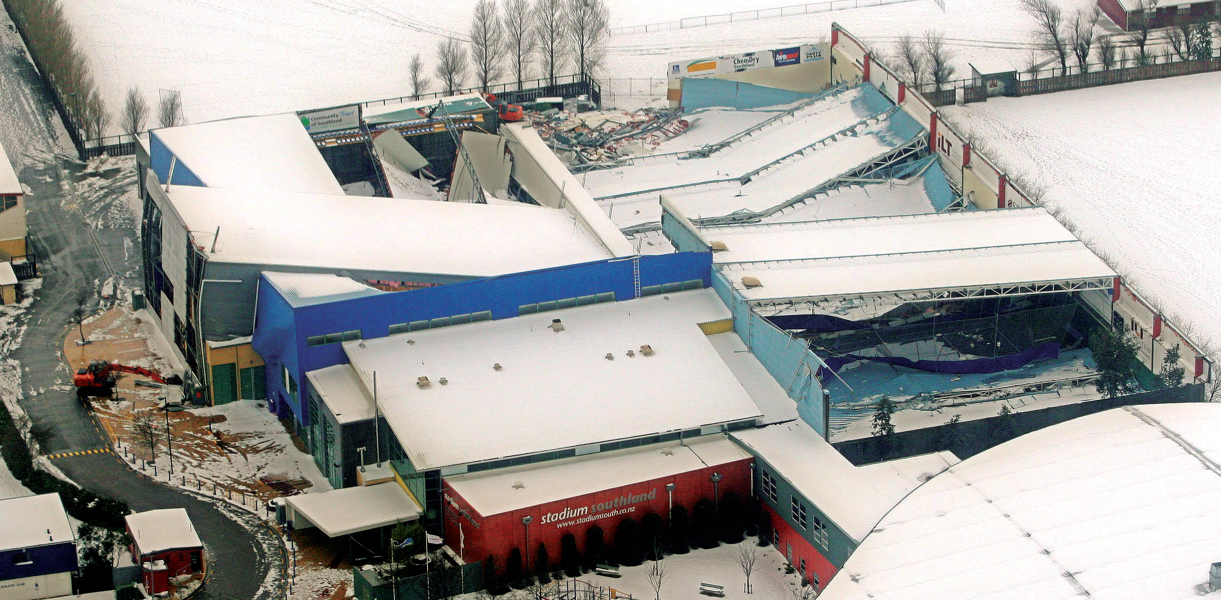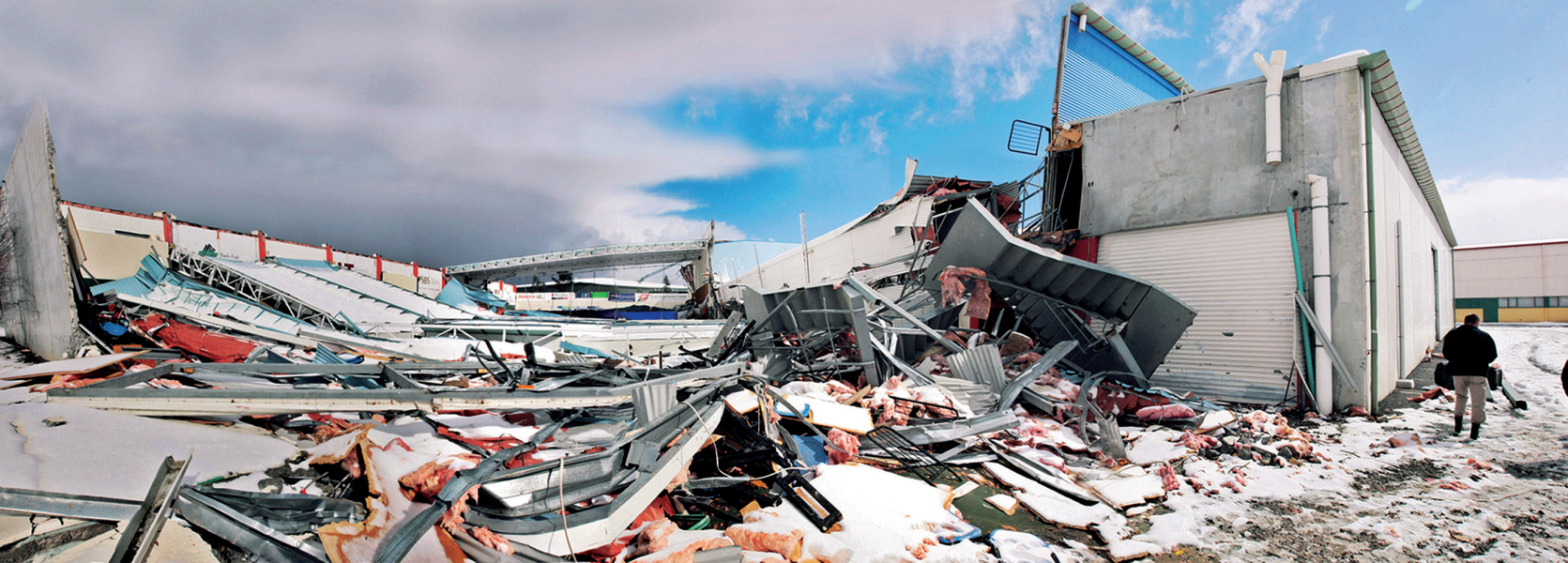The collapse of the Southland Stadium in 2010 highlighted how little we know about snow-loading hazards. Can New Zealand buildings stand up to a heavy dump? Greta Shirley finds out...
A hot shower may well have saved Keiran Fahy's life. The Invercargill insurance broker had been at the covered Southland Stadium all morning, coaching kids' tennis. "We didn't really have much indication of what was going on outside," he recalls.
If they had, they would have seen Invercargill hit by one of the most severe snowstorms in living memory. Over Friday 17 September, the low pressure system tracked south and east across the Southern Ocean, loading with cold Antarctic air before turning north. In the early hours of Saturday, gelid and sodden, it crossed the Southland coast, unleashing 16 hours of heavy snowfall, followed by intermittent snow, rain, hail and sleet.
At 11.00 am, anxious parents showed up at Fahy's tennis class, keen to get their kids home before the snow got too deep.
He decided to take a shower. Minutes later, the stadium roof collapsed, dragging with it sections of the east and west walls, and the main roof 'spine' trusses. Inside, Fahy heard "a hell of a lot of noise" before the stadium gave a convulsive shudder. "The roof came down as one, and it created a hurricane going down the corridor."
Outside, parents and kids reported a loud "explosion" as the building collapsed into the space they'd just left. Doors at the eastern end of the courts blew open, and roof panels flew past. Fahy, still not fully aware of his peril, headed for the exit.
"People outside were doing a bit of a head count," he says, "and saw me wandering out. They used a few expletives to express their need for me to hurry up.
"The whole show was just wide open. There was no roof there at all. That's when I said a few four-letter words myself."
In Yarrow Street, the roof of Wren's paint shop also succumbed, as did part of the Windsor New World supermarket. Roof trusses in Farmers department store and The Warehouse both groaned under the weight of the extreme snow fall. Evandale Gardens and two workshops owned by Southern Transport were also damaged. Somehow, nobody was killed or injured.
Within hours, NIWA scientists were collecting snow data from around the stadium – that would later be used by the then Department of Building and Housing (DBH) in an investigation into the collapse.
The New Zealand Building Code sets out the minimum performance standards buildings have to meet – such as the strongest earthquake they must endure, or how much snow or wind they can withstand. "What the Code does," explains Cameron Smart, Engineering Projects Manager of the Institution of Professional Engineers New Zealand (IPENZ) "is give you different methods for demonstrating compliance."
More information on the New Zealand Building Code
The joint Australia/New Zealand standard – AS/NZS1170.3 (with some Building Code amendments) is a verification method for defining the snow load to be used when designing a building.
Follow the calculations outlined in the standard, which figure in location, altitude and building type, and you get a minimum ground snow load (Sg), measured in kilopascals (kPa). Sg is the pressure snow would ordinarily exert on the ground and, therefore, what the building must also withstand. Hospitals and other populous buildings must be able to cope with higher snow loads than a private house.
The Southland snowfall wasn't an isolated event. In June 2006, a large storm dumped record snows on parts of Canterbury, collapsing several buildings and disrupting electricity networks, communication and transport systems. At DBH's request, NIWA also researched the snow loads exerted by that storm, which reached 1.2kPa at a Timaru weighbridge – four times the acceptable one-in-25-year limit in the Building Code of the time.
NIWA's subsequent report highlighted instances where observed ground snow loading had even surpassed the one-in-150-year standard, and said that the snow densities specified in the AS/NZS standard were a "key deficiency." That was the first time doubts were expressed about the building standards, says NIWA meteorologist, Dr Richard Turner. "People started asking a little bit more about where the numbers had come from."
NIWA recommended that a systematic data collection system be set up for future severe low-elevation snowstorms, and that variations to the standards might also be required. For example, it has been observed overseas that snow density increases with snow depth and yet the AS/NZS standard ignores this effect. In 2008, the Building Code was duly strengthened for low-altitude sites in Canterbury and Southland.
Turner, and his NIWA colleague, applied hydrologist Dr Christian Zammit, are fascinated by the white stuff. They gather important information for DBH by measuring snow depth and density at different locations.
"We call it a snow mobilisation exercise," says Zammit. "When the big storm hit Canterbury in June this year, we went out measuring snow-related information, such as depth and vertical density at specific locations. We also propose doing this type of measurement at existing climate stations, so we can build up a time series that allows us to evaluate additional information, such as the return period of a snow event."
Says Zammit, the Department and others are also interested in the adequacy of the current snow standards, which "are based mainly on Australian and American snow data, because of the lack of information here."
Understanding how much snow falls, says Adrian Bennett, and how dense it is, is critical to designing buildings, "so they perform satisfactorily throughout their lives, don't collapse and don't endanger occupants." Bennett, Manager of Building Science and Research at the Ministry of Business, Innovation and Employment's Building and Housing Group (formerly DBH), says that, while the current standard includes snow loads, "in recent times, there appears to be an increased frequency of significant snow events in sub-alpine areas. This means the snow load data need to be updated, and the design information improved."
Cameron Smart is less convinced: "Having worked in the snow and wind areas for quite some time, it seems to me the present standard, modified by the Code, is about right. But the way ground snow load is translated into load on a roof – that's worth looking at." He's also curious about precisely how snow accumulates against the sides of buildings, and "one very dear to my own heart" – what happens when wind combines with snow.
Zammit and Turner, however, favour erring on the side of caution, especially after the Christchurch earthquakes put the spotlight on building resilience. "We're not seeing buildings collapsing regularly from snow," accepts Turner, "but it's a bit of an unknown because we lack good long-term measurements in New Zealand."
Zammit says current standards are probably adequate in 95 per cent of cases, but we need a lot more data before we can be sure, especially at low elevations: "anywhere below 200 metres, where snow is only going to occur perhaps once or twice a year, but could possibly have huge consequences."
New Zealand snow is still something of an unknown. For example, does our maritime weather environment make it wetter or drier, heavier or lighter? Snow depth and density, says Zammit, do not always correlate: "For the same snow depth, you could get anything between 75kg per cubic metre for fresh snow, up to 400–600kg for wet snow."
How a warming climate might impact on future snow storms is also unclear. NIWA modelling suggests we will see a general decrease in snow at high altitudes, but a warmer climate will also bring more precipitation, which could mean we'll see more extreme snow events at lower altitudes.
NIWA's Chief Scientist, Natural Hazards, Dr Murray Poulter, says there's more that could be done to improve "how accurately we estimate the probability of ground snow load, and combined high wind-snow load events." Also, he says, we need to better quantify "how snow, ice and wind interact with infrastructure, such as buildings and power line networks."
Prior warning, he says, is "our next best weapon. We've adapted a weather model to predict snow amounts, using NIWA's specialist environmental monitoring service EcoConnect. In the future, this tool could be used to help alert utility operators of possible infrastructure damage from snow, and the need to have repair crews on standby."
Find out more about out EcoConnect service
Stadium Southland was, in fact, designed to meet snow load requirements first published in 1992, and still in effect when it was built in 1999 (the 2008 revisions were much more stringent).
An investigation into the collapse, commissioned by DBH and conducted by engineering consultants Ashley Smith (StructureSmith Ltd) and Dr Clark Hyland (Hyland Consultants Ltd), included a site examination, laboratory testing and 3D computer analysis. It concluded that snow load alone couldn't explain the structure's failure. Problems with remedial works during construction, construction defects and design issues were also implicated in its downfall.
Smith and Hyland calculated snow load at the time was around 0.3kPa. A day after the collapse, NIWA measured the average ground snow load at 0.45kPa, although it's possible that was bolstered by sleet, rain and further snow subsequent to the collapse. Had the stadium been built to 2008 standards, the design roof load for the building would have been 0.63kPa – a 60 per cent safety margin.
DBH therefore concluded that the 2008 Code requirement, still in force, remained sufficient. Other Smith and Hyland recommendations, including that DBH provide guidance on the design of roofs subject to snow loading, were accepted. The Department is also considering a requirement that public buildings carry snow alarms to warn occupants when loads reach specified limits.
The report was referred to the New Zealand Police and Department of Labour for further consideration, and to IPENZ – the body responsible for industry competence.
The New Zealand Insurance Council put the final cost of the Southland storm at more than $50 million, including a $20–25 million repair bill for the stadium.
The hairs on Keiran Fahy's neck still stand up when a truck goes past. "It's that same sort of shuddery feeling, as when the roof came down, forcing air down the wee narrow corridor near the stadium changing rooms. That tickles me up a bit."
Anything more we can learn about snow events and snow loads, he reckons, is a good thing. "At the end of the day, the stadium was built within the confines of the regulations they had to design to at the time. I guess all you can be thankful for is that no one got killed or injured ... with a bit of luck, they'll learn this time round, when they build the new one."
End
Let it snow, let it snow, let it snow ...
Snow is precipitation in near, or below, freezing temperatures.
Snow hazards generally happen in our mountain areas, the central North Island, and the south and east of the South Island, but snow occasionally falls elsewhere. Last year, snow fell in Wellington, Hamilton and even central Auckland.
Analysis of NIWA's historic weather events database shows that a total of 39 snowstorms have damaged property and infrastructure, or killed livestock and/or people.
More information about our historic weather events database
Four of these occurred prior to 1945, three during the 1970s, one in the 1980s and four in the 1990s. Twenty-seven snowfall incidents have been recorded since 2000.
Recent significant snowfalls include:
- June 2006 – Canterbury
- September 2010 – Southland
- July 2011 – Canterbury
- August 2011 – Canterbury and Wellington (snow also fell in Auckland and Hamilton)
- June 2012 – Canterbury
Wiki science: how you can help gather more snow data
The public can help gather data under a NIWA system which analyses snowfall at low elevations around New Zealand. The results will tell us more about how snowfall occurs, and will help quantify snow-related risks.
During the South Island snowstorm in June this year, NIWA received more than 40 measurements from the public, from Dunedin to Rangiora.
If you live below 400m elevation, and it snows, send us your measurements of the snow depth and snow water equivalent.




